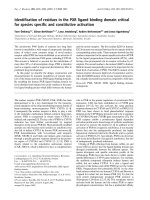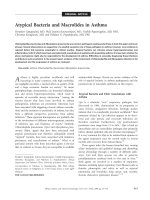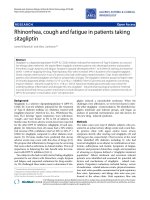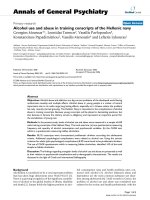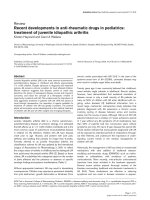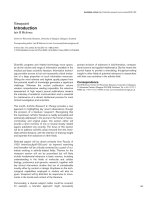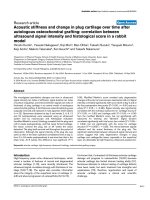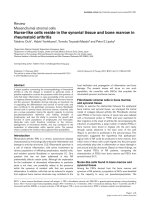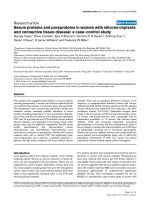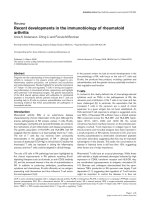Báo cáo y học: " Recent developments and strategies in pediatric pharmacology research in the USA" ppsx
Bạn đang xem bản rút gọn của tài liệu. Xem và tải ngay bản đầy đủ của tài liệu tại đây (208.36 KB, 5 trang )
BioMed Central
Page 1 of 5
(page number not for citation purposes)
Child and Adolescent Psychiatry and
Mental Health
Open Access
Review
Recent developments and strategies in pediatric pharmacology
research in the USA
Benedetto Vitiello
Address: Child and Adolescent Treatment and Preventive Intervention Research Branch, Division of Services and Intervention Research, National
Institute of Mental Health, Bethesda, Maryland, USA
Email: Benedetto Vitiello -
Abstract
Research in pediatric pharmacology has undergone major changes in the last ten years, with an
expansion in both publicly and privately funded activities. A number of pharmacokinetics studies
and multi-site controlled efficacy trials have been conducted, so that treatment of children and
adolescents can now be better informed and evidence-based. Regulatory financial incentives to
industry in return for studies on drugs still covered by patent exclusivity have resulted in a
substantial increase in pediatric research funded by pharmaceutical companies. In parallel, public
funding has supported research on off-patent medications and other clinical important aspects of
treatment, such as comparisons between active treatments, including non-pharmacological
interventions. With greater interest by industry in pediatric research, the role of government
funding agencies has been redefined to avoid duplication and ensure better integration of efforts
and utilization of resources. The present review discusses some of the recent developments in
pediatric pharmacology with focus on psychiatric medications.
Background
The last ten years have witnessed both a significant expan-
sion of pediatric pharmacology research and a redefini-
tion of the roles of public and private sources in
supporting such research. Traditionally a neglected area of
medicine, research on medication effects in children was
brought to the center of the attention in the 1990s [1,2].
The realization that the pediatric use of medications was
expanding without adequate evidence for efficacy and
safety spurred a number of initiatives in the U.S. [3,4].
On one hand, the National Institutes of Health (NIH)
established research networks devoted to testing in chil-
dren the pharmacokinetics, efficacy, and safety of com-
monly prescribed medications that were approved by the
U.S. Food and Drug Administration (FDA) only for adult
use ("off-label use") [5,6]. On the other hand, legislation
was enacted to provide incentives to the pharmaceutical
industry for sponsoring pediatric studies [7-10]. As a con-
sequence, a variety of funding sources and possible strate-
gies has become available for conducting systematic
investigations in child and adolescent pharmacology. The
aim of this review is to discuss some of the recent devel-
opments in pediatric pharmacology research in the U.S.A.,
and examine strategies and approaches to conducting
investigations in children with special focus on psychop-
harmacology.
Publicly funded research
Most of the funding in pediatric pharmacology research
by the NIH is provided through investigator-initiated
grant applications, which undergo rigorous peer-review.
Over the years, this mechanism has supported a large part
of pharmacology research relevant to children. In fact,
Published: 8 December 2008
Child and Adolescent Psychiatry and Mental Health 2008, 2:36 doi:10.1186/1753-2000-2-36
Received: 6 August 2008
Accepted: 8 December 2008
This article is available from: />© 2008 Vitiello; licensee BioMed Central Ltd.
This is an Open Access article distributed under the terms of the Creative Commons Attribution License ( />),
which permits unrestricted use, distribution, and reproduction in any medium, provided the original work is properly cited.
Child and Adolescent Psychiatry and Mental Health 2008, 2:36 />Page 2 of 5
(page number not for citation purposes)
prior to the legislative changes of 1997 [7], industry had
little interest in pediatric research, even in the case of
widely used medications. For example, the first trial show-
ing the efficacy of fluoxetine in childhood depression was
funded through a public grant [11].
Besides funding investigator-initiated research, NIH
launched a number of initiatives in areas of high public
health significance. In the mid-1990s, research networks
were started to specifically investigate pediatric pharma-
cology. The Pediatric Pharmacology Research Units
(PPRUs) and the Research Units on Pediatric Psychophar-
macology (RUPPs) were funded by the National Institute
of Child Health and Human Development (NICHD) and
the National Institute of Mental Health (NIMH), respec-
tively [4,5]. The PPRUs have focused on evaluating the
pharmacokinetics and efficacy of drugs commonly used in
general pediatrics, and thus provided an infrastructure of
highly specialized academic research settings where both
NIH- and industry-funded studies can be conducted
[12,13].
Also based at academic sites, the RUPPs conducted con-
trolled clinical trials of the efficacy of psychiatric medica-
tions used off-label in the community, such as the
selective serotonin reuptake inhibitor (SSRI) fluvoxamine
for the treatment of pediatric anxiety disorders and the
antipsychotic risperidone in children with autism and
severe behavioral problems [14,15]. In addition to
research networks, NIMH has funded multisite clinical tri-
als to address specific questions of high clinical relevance
to the treatment of children with attention deficit/hyper-
activity disorder (ADHD), adolescent depression, early
onset schizophrenia, anxiety disorders, and bipolar disor-
der [5,16-20].
The increasing interest of industry in pediatric research
that had been traditionally supported by NIH had led to a
redefinition of the role of public funding, which is now
focused on investigating important aspects of pharmacol-
ogy that go beyond traditional pharmacokinetics or effi-
cacy testing versus placebo. In particular, comparisons of
the effectiveness of alternative specific interventions and
treatment strategies have been the object of recent NIMH-
funded clinical trials with the aim of providing clinicians
and families with the data necessary for informed treat-
ment decisions. Thus, in the case of ADHD and adolescent
depression, conditions for which both pharmacological
and psychotherapeutic interventions are available, NIMH
funded large trials to compare the effectiveness of these
treatments used as monotherapy or in combination
[16,21]. Likewise, a publicly funded comparative trial of
different antipsychotics for youths with schizophrenia
was recently completed [20]. Some of these studies have
also produced informative cost-effectiveness analyses that
should help better allocate health care resources [22,23].
Evaluating the effectiveness of interventions in clinical set-
tings requires an investigational approach and a research
infrastructure that are different from those of the tradi-
tional efficacy trials, which are typically conducted in
research settings and are characterized by high internal
but low external validity [24]. To this end, efforts are
under way to create a child psychiatry practice-based net-
work where observational studies and pragmatic clinical
trials could be conducted in a rapid and efficient way
[25,26].
Other areas relevant to pediatric pharmacology that have
received little attention from industry are: a) the develop-
ment of treatments for autism, other pervasive develop-
mental disorders, and rare disorders such as Tourette's
disorder and child schizophrenia; b) pharmacoepidemi-
ology research; c) meta-analyses; d) bioethics research; e)
development of novel methodological tools to assess
treatment effects and safety; and f) evaluations of the
impact of treatment on long-term illness trajectories and
distal prognosis [4,27]. It is evident that the research
agenda in pediatric pharmacology now extends well
beyond the traditional and essential component of phar-
macokinetics and efficacy testing of efficacy, and involves,
among the others, comparative studies of treatment strat-
egies, systematic analyses of community patient data-
bases, and active post-marketing surveillance for a more
effective pharmacovigilance. Finally, as discussed more in
details further down, a specific role of NIH under the Best
Pharmaceuticals for Children Act of 2002 [8] is to support
pediatric studies of off-patent drugs, thus integrating and
complementing the exclusivity extension initiative that
applies to patented drugs.
Industry-funded research
As mentioned, the involvement of industry in pediatric
research had been rather limited until the late 1990s. This
situation substantially changed in the U.S. with the enact-
ment of legislation providing pharmaceutical companies
with an additional six months of drug patent exclusivity
protection in return for conducting specific studies in chil-
dren [7]. The legislation, initially enacted in 1997, and
then confirmed and expanded in 2002 and 2007 [8,10],
has provided a powerful incentive for industry-funded
pediatric research.
For example, industry has funded most of the placebo-
controlled efficacy trials of stimulants and antidepressants
during the last ten years, thus providing the data for recent
meta-analyses conducted by the FDA and academic
researchers [28-30].
Child and Adolescent Psychiatry and Mental Health 2008, 2:36 />Page 3 of 5
(page number not for citation purposes)
The exclusivity extension program has been successful in
stimulating industry-funded research in pediatric pharma-
cology in the U.S. [31]. Knowledge of the medication dos-
ing appropriate to children has been expanded [32]. From
1998 through May 2008, more than three hundred stud-
ies have been conducted and 148 changes in drug labeling
implemented consequent to research conducted by indus-
try under the pediatric exclusivity program [33]. About
half of these studies were aimed at testing efficacy, a third
at examining pharmacokinetics, and one fifth at evaluat-
ing safety.
The overall positive result of this legislative is reflected in
the decision of the European Union to enact similar
incentives to industry for pediatric research [34,35].
Independent analyses of the economic cost and return to
industry of the pediatric exclusivity program have been
reported [36]. When research conducted on nine drugs
was considered, the cost to industry ranged from $5 to
$44 million, with a median of $12.3 million. The net
return ranged from $9 to $508 million, with a median of
$140 million, and the ratio return/cost went from -0.68 to
73.63. Obviously, the return depends on the magnitude
of the overall market of the drug, including both pediatric
and adult market. Thus, in the case of a widely prescribed
antidepressant, pediatric studies with a cost of $35 mil-
lion translated into a return of $242 million, for return/
cost ratio of 7 [36].
Notwithstanding the overall success of the pediatric exclu-
sivity program in fostering research, a number of limita-
tions have been identified and several concerns raised,
some of which have been addressed during the re-author-
ization of the program. Because the exclusivity is granted
for completing specific studies within a certain period of
time, but not necessarily for demonstrating efficacy, there
may be pressure to conduct studies quickly, and ensuring
high quality of research under time pressure can be chal-
lenging. Moreover, it was observed that the types of stud-
ies conducted under the pediatric exclusivity program
tend to match more adult use than actual pediatric needs
[37].
Concern was also raised that, as typical for industry-spon-
sored research, the data belong to the sponsor, and results
may not be necessarily or promptly published, or the pub-
lications may be influenced by the source of funding [38-
41]. Newly enacted legislation tries to address this con-
cern by mandating that the results of all the pediatric stud-
ies conducted under the exclusivity program be posted on
the FDA Website />maryreview.htm. More in general, the reported associa-
tion between sponsorship and research outcome should
provide further impetus to supporting publicly funded
research programs as a way to both counterbalance and
complement industry-funded research.
In addition to research conducted under the pediatric
exclusivity program, there has been an increased general
interest of pharmaceutical companies in the pediatric
market. In fact, the increased pediatric use of medications
has created, in some cases, a sizeable enough market to
justify funding research programs specifically focused on
pediatrics. For instance, the use of medications for ADHD
has considerably increased over the years, thus making
ADHD the object of novel treatment development, as
shown by the introduction into the market of atomoxet-
ine and of several new preparations of stimulants [42].
Likewise, the realization that autism spectrum disorders
are much more common than once thought is stimulating
industry to conduct research of potential treatments for
these conditions.
The Pediatric Research Equity Act of 2003 [9] gives FDA
the authority to request that pharmaceutical companies
pursuing a new drug registration for adult indications
conduct also pediatric studies whenever the medication is
potentially relevant to pediatric use. This act is expected to
address the need for information in pediatric pharmacol-
ogy prospectively and proactively, before drugs actually
enter the market, thus preventing or minimizing off-label
use. The full impact of this initiative will take a few years
to be evaluated.
A Multiple Party Process
Successful implementation of pediatric pharmacology
research depends on a close interplay among multiple
parties, and most notably NIH, FDA, industry, and aca-
demic investigators [43]. As discussed, for drugs that are
currently marketed and still covered by patent, pediatric
studies can be conducted by industry under agreement
with the FDA in return for a six-month extension of patent
exclusivity. For drugs currently marketed but already off-
patent, the NIH and FDA collaborate towards reviewing
the need for pediatric research and preparing an annual
priority list, based on which FDA requests specific studies
of industry. However, because these drugs are off patent,
there are few financial incentives to conduct research, and
these requests are often rejected. In these cases, NIH takes
responsibility for organizing and funding the studies. This
process was recently followed for funding a series of stud-
ies that are now in progress to evaluate the pharmacoki-
netics and efficacy of lithium in the treatment of children
with bipolar disorder [44,45].
Finally, for drugs that are still in a pre-registration phase
of development and not yet marketed, FDA can request
pediatric studies as appropriate. Thus, the recently intro-
duced regulations provide a truly comprehensive process
Child and Adolescent Psychiatry and Mental Health 2008, 2:36 />Page 4 of 5
(page number not for citation purposes)
that covers medications in different stages of development
and marketing.
While integration and coordination of efforts and activi-
ties between government agencies and industry is critical,
there are other parties whose role is essential for pediatric
pharmacology research. Designing and conducting pedi-
atric research require specific knowledge of methodology
and bioethics, and therefore rely on the availability of a
properly trained cadre of investigators who have acquired
the necessary expertise. Even though the number of pedi-
atric investigators has increased over recent years, pediat-
ric pharmacology remains a relatively small field with
limited capacity.
Another critical component is the participation of chil-
dren and their families in pediatric research. Children are
considered a vulnerable population for research purposes
and special regulations must be followed for conducting
pediatric research [46]. The recent expansion of pediatric
pharmacology research has brought attention to the need
for better understanding the critical elements of child
research participation and improving the implementation
and validity of the relevant bioethical procedures [47].
Enrollment in clinical trials is often a slow process that
takes several years to be completed. Various strategies for
engaging both practitioners and potential research partic-
ipants have been proposed, and greater attention on the
part of researchers to the perspectives and needs of chil-
dren and families have been recommended [43,48].
Conclusion
Knowledge on the effects of medications in children has
significantly expanded in recent years due to an increase
in publicly funded research and legislative initiatives pro-
viding financial incentives to industry. Further progress
will depend on coordination and integration of efforts
across the different parties. It will be especially important
to sustain and expand the research infrastructure that has
been built over recent years, and develop more rapid and
efficient ways of conducting clinical trials in pediatric
populations. It will be also critical to increase the collabo-
rations and coordination of efforts between the U.S.,
Europe, and other countries with the aim of achieving
greater standardization of research methodology and
sharing of research data, The specific research agenda will
depend in large part on the emergence of novel, promis-
ing treatments, and on the identification of timely clinical
questions of major public health relevance. Clearly, both
a public and private vigorous involvement in pediatric
research will be needed to address the diverse and com-
plex medical needs of children.
Competing interests
The author declares that he has no competing interests.
Acknowledgements
Based on a presentation at the Europaeische Akademie Conference on
Clinical Research in Vulnerable Populations, Berlin, Germany, April 3–4,
2008.
The opinions and assertions contained in this report are the private views
of the author and are not to be construed as official or as reflecting the
views of the National Institute of Mental Health, the National Institutes of
Health, or the Department of Health and Human Services.
References
1. American Academy of Pediatrics Committee on Drugs: Unap-
proved uses of approved drugs: the physician, the package
insert, and the Food and Drug Administration. Pediatrics 1996,
98:143-145.
2. Vitiello B, Jensen PS: Medication development and testing in
children and adolescents. Arch Gen Psychiatry 1997, 54:871-876.
3. Jensen PS, Bhatara VS, Vitiello B, Hoagwood K, Feil M, Burke LB: Psy-
choactive medication prescribing practices for US children:
Gaps between research and clinical practice. J Am Acad Child
Adolesc Psychiatry 1999, 38:557-565.
4. Vitiello B: Research in Child and Adolescent Psychopharma-
cology: Recent Accomplishments and New Challenges. Psy-
chopharmacol 2007, 191:5-13.
5. Cohen S: The Pediatric Pharmacology Research Unit (PPRU)
network and its role in meeting pediatric labeling needs.
Pediatrics 1999, 104:644-645.
6. Vitiello B: An update on publicly funded multisite trials in
pediatric psychopharmacology. Child Adolesc Psychiatr Clin N Am
2006, 15:1-12.
7. U.S. Congress: Food and Drug Administration Modernization
Act. Public Law 1997:105-115.
8. U.S. Congress: Best Pharmaceuticals for Children Act
(BPCA). Public Law 2002:107-109.
9. U.S. Congress: Pediatric Research Equity Act of 2003. Public
Law 2003:108-155.
10. U.S. Congress: Food and Drug Administration Amendments
Act of 2007. Public Law 2007:115-85.
11. Emslie GJ, Rush AJ, Weinberg WA, Kowatch RA, Hughes CW, Car-
mody T, Rintelmann J: A double-blind, randomized, placebo-
controlled trial of fluoxetine in children and adolescents with
depression. Arch Gen Psychiatry 1997, 54:1031-1037.
12. Blumer JL, Saiman L, Konstan MW, Melnick D: The efficacy and
safety of meropenem and tobramycin vs ceftazidime and
tobramycin in the treatment of acute pulmonary exacerba-
tions in patients with cystic fibrosis.
Chest 2005, 128:2336-2346.
13. Blumer JL, Reed MD, Steinberg F, O'Riordan MA, Rosen CL, Springer
MA, Christensen M, Glaze D: Potential pharmacokinetic basis
for zolpidem dosing in children with sleep difficulties. Clin
Pharmacol Ther 2008, 83:551-558.
14. Research Units on Pediatric Psychopharmacology Anxiety Study
Group: Fluvoxamine for the treatment of anxiety disorders in
children and adolescents. N Engl J Med 2001, 344:1279-1285.
15. Research Units on Pediatric Psychopharmacology Autism Network:
Risperidone in children with autism and serious behavioral
problems. N Engl J Med 2002, 347:314-321.
16. The MTA Cooperative Group: A 14-month randomized clinical
trial of treatment strategies for attention-deficit/hyperactiv-
ity disorder (ADHD). Arch Gen Psychiatry 1999, 56:1073-1086.
17. Greenhill LL, Abikoff H, Chuang S, Cooper T, Cunningham C, Davies
M, Ghuman J, Kollins S, McCracken JT, McGough J, Posner K, Riddle
MA, Skrobala A, Swanson A, Vitiello B, Wigal S, Wigal T: Efficacy
and safety of immediate-release methylphenidate treatment
for preschoolers with ADHD. J Am Acad Child Adolesc Psychiatry
2006, 45:1284-1293.
18. Treatment for Adolescents with Depression Study (TADS) Team:
Fluoxetine, cognitive-behavioral therapy, and their combi-
nation for adolescents with depression. JAMA 2004,
292:807-820.
19. Brent D, Emslie G, Clarke G, Wagner K, Asarnow J, Keller M, Vitiello
B, Ritz L, Satish Iyengar S, Abebe K, Birmaher B, Ryan N, Kennard B,
Hughes C, DeBar L, McCracken J, Strober M, Suddath R, Spirito A,
Leonard H, Porta G, Onorato M, Zelazny J: The Treatment of
Adolescents with SSRI-Resistant Depression (TORDIA): a
Publish with BioMed Central and every
scientist can read your work free of charge
"BioMed Central will be the most significant development for
disseminating the results of biomedical research in our lifetime."
Sir Paul Nurse, Cancer Research UK
Your research papers will be:
available free of charge to the entire biomedical community
peer reviewed and published immediately upon acceptance
cited in PubMed and archived on PubMed Central
yours — you keep the copyright
Submit your manuscript here:
/>BioMedcentral
Child and Adolescent Psychiatry and Mental Health 2008, 2:36 />Page 5 of 5
(page number not for citation purposes)
comparison of switch to venlafaxine or to another SSRI, with
or without additional cognitive behavioral therapy. JAMA
2008, 299:901-913.
20. Sikich L, Frazier JA, McClellan , Findling RL, Vitiello B, Ritz L, Ambler
D, Puglia M, Maloney AE, Hunt-Harrison T, Jackson JA, De Jong S,
Slifka K, Noyes N, Michael E, Hlastala S, Pierson L, McNamara NK,
Delporto-Bedoya D, Anderson R, Hamer RM, Lieberman JA: Dou-
ble-blind comparison of antipsychotics in early onset schizo-
phrenia and schizoaffective disorder. Am J Psychiatry 2008 in
press.
21. The TADS Team: The Treatment for Adolescents with
Depression Study (TADS): long-term effectiveness and
safety outcomes. Arch Gen Psychiatry 2007, 64:1132-1144.
22. Jensen PS, Garcia JA, Glied S, Crowe M, Foster M, Schlander M, Hin-
shaw S, Vitiello B, Arnold LE, Elliott G, Hechtman L, Newcorn JH, Pel-
ham WE, Swanson J, Wells K: Cost-effectiveness of ADHD
treatments: findings from the Multimodal Treatment Study
of Children with ADHD. Am J Psychiatry 2005, 162:1628-1636.
23. Domino M, Burns BJ, Silva SG, Kratochvil CJ, Vitiello B, Reinecke MA,
Mario J, March JS: The cost-effectiveness of treatments for ado-
lescent depression: results from the TADS randomized trial.
Am J Psychiatry 2008, 165:588-596.
24. March JS, Silva SG, Compton S, Shapiro M, Califf R, Krishnan R: The
case for practical clinical trials in psychiatry. Am J Psychiatry
2005, 162:836-846.
25. March JS, Silva SG, Compton S, Antgony G, DeVeaugh-Giess J, Califf
R, Krishnan R: The Child and Adolescent Psychiatry Trials
Network (CAPTN). J Am Acad Child Adolesc Psychiatry 2004,
43:515-518.
26. Wehmeier PM, Schacht A, Lehmann M, Dittmann RW, Silva SG,
March JS: Emotional well-being in children and adolescents
treated with atomoxetine for attention-deficit/hyperactivity
disorder: Findings from a patient, parent and physician per-
spective using items from the pediatric adverse event rating
scale (PAERS). Child Adolesc Psychiatry Ment Health 2008, 2(1):11.
27. Vitiello B, Heiligenstein JJ, Riddle MA, Greenhill LL, Fegert JM: The
interface between publicly funded and industry-funded
research in pediatric psychopharmacology: opportunities for
integration and collaboration. Biol Psychiatry 2004, 56:3-9.
28. Mosholder AD, Willy M: Suicidal adverse events in pediatric
randomized, controlled clinical trials of antidepressant drugs
are associated with active drug treatment: a meta-analysis.
J Child Adolesc Psychopharmacol 2006, 16:25-32.
29. Hammad TA, Laughren T, Racoosin J: Suicidality in pediatric
patients treated with antidepressant drugs. Arch Gen Psychiatry
2006, 63:332-339.
30. Bridge JA, Iyengar S, Salary CB, Barbe RP, Birmaher B, Pincus HA, Ren
L, Brent DA: Clinical response and risk for reported suicidal
ideation and suicide attempts in pediatric antidepressant
treatment: a meta-analysis of randomized controlled trials.
JAMA 2007, 297:1683-1696.
31. Roberts R, Rodriguez W, Murphy D, Crescenzi T: Pediatric drug
labeling – Improving the safety and efficacy of pediatric ther-
apies. JAMA 2003, 290:905-911.
32. Rodriguez WJ, Roberts R, Murphy D: Improving pediatric dosing
through pediatric initiatives: what we have learned. Pediatrics
2008, 121:530-9.
33. U.S. Food and Drug Administration: Pediatric exclusivity labeling
changes. Center for Drug Evaluations and Research. [http://
www.fda.gov/cder/pediatric/labelchange.htm]. (accessed June 18,
2008).
34. Kolch M, Schnoor K, Fegert JM: The EU-regulation on medicinal
products for paediatric use: impacts on child and adolescent
psychiatry and clinical research with minors. Eur Child Adolesc
Psychiatry 2007, 16:229-235.
35. Auby P: Pharmaceutical research in paediatric populations
and the new EU pediatric legislation: an industry perspec-
tive. Child Adolesc Psychiatry Mental Health 2008 in press.
36. Li JS, Eisenstein EL, Grabowski HG, Reid ED, Mangum B, Schulman
KA, Goldsmith JV, Murphy MD, Califf RM, Benjamin DK: Economic
return of clinical trials performed under the pediatric exclu-
sivity program. JAMA 2007, 297:480-488.
37. Boots I, Sukhai RN, Klein RH, Holl RA, Wit JM, Cohen AF, Burggraaf
J: Stimulation programs for pediatric drug research – do chil-
dren really benefit? Eur J Pediatr 2007, 166:849-855.
38. Benjamin DK, Smith PB, Murphy MD, Roberts R, Mathis L, Avant D,
Califf RM, Li JS: Peer-reviewed publication of clinical trials
completed for pediatric exclusivity. JAMA 2006, 296:1266-1273.
39. Als-Nielsen B, Chen W, Gluud C, Kjaergard LL: Association of
funding and conclusions in randomized drug trials. JAMA
2003, 290:921-928.
40. Tongeji T, Poole R: Influence of drug company authorship and
sponsorship on drug trial outcomes. Br J Psychiatry 2007,
191:82-83.
41. Turner EH, Matthews AM, Linardatos E, Tell RA, Rosenthal R: Selec-
tive publication of antidepressant trials and its influence on
apparent efficacy. N Engl J Med 2008, 358:252-260.
42. Michelson D, Faries D, Wernicke J, Kelsey D, Kendrick K, Sallee FR,
Spencer T: Atomoxetine in the treatment of children and ado-
lescents with attention-deficit/hyperactivity disorder: a ran-
domized, placebo-controlled, dose-response study. Pediatrics
2002, 108:E83.
43. DeVeaugh-Geiss J, March J, Shapiro M, Andreason PJ, Emslie G, Ford
LM, Greenhill L, Murphy D, Prentice E, Roberts R, Silva S, Swanson
JM, van Zwieten-Boot B, Vitiello B, Wagner KD, Mangum B: Child
and adolescent psychopharmacology in the new millennium:
a workshop for academia, industry, and government. J Am
Acad Child Adolesc Psychiatry 2006, 45:261-270.
44. Findling RL, Frazier JA, Kafantaris V, Kowatch R, McClellan J, Pavuluri
M, Sikich L, Hlastala S, Hooper SR, Demeter CA, Bedoya D, Brown-
stein B, Taylor-Zapata P: The Collaborative Lithium Trials
(CoLT): specific aims, methods, and implementation. Child
Adolesc Psychiatry Ment Health 2(1):21. 2008 Aug 12;
45. Taylor-Zapata P, Mattison DR: Making progress for how medica-
tions are used in children. Arch Ped Adolesc Med 2007, 161:916.
46. Vitiello B: Ethical considerations in psychopharmacological
research involving children and adolescents. Psychopharmacol
2003, 171:86-91.
47. Vitiello B: Effectively obtaining informed consent for child and
adolescent participation in mental health research. Ethics &
Behavior 2008, 18:182-198.
48. Hinshaw SP, Hoagwood K, Jensen PS, Kratochvil C, Bickman L, Clarke
G, Abikoff HB, Atkins M, Vitiello B: AACAP 2001 Research
Forum: Challenges and Recommendations Regarding
Recruitment and Retention of Participants in Research
Investigations. J Am Acad Child Adolesc Psychiatry 2004,
43:1037-1045.
